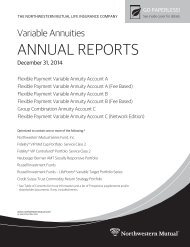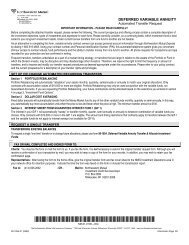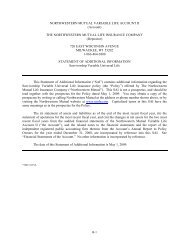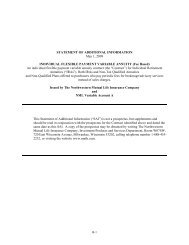corresponding floaters. The underlying security may then be held or sold. However, typically, there aretime constraints and other limitations associated with any right to combine interests and claim theunderlying security.Floater holders subject to a Dutch Auction procedure generally do not have the right to put back theirinterests to the issuer or to a third party. If a Dutch Auction fails, the floater holder may be required tohold its position until the underlying bond matures, during which time interest on the floater is capped at apredetermined rate.The second market for floaters and inverse floaters may be limited. The market value of inversefloaters tends to be significantly more volatile than fixed rate bonds.Tracers SM /Trains SMThe Fixed Income Portfolios may invest in TRACERS and TRAINS which represent ownershipof a specified percentage of each security in an underlying pool of securities. Owners are entitled toreceive a pro rata share of distributions from the underlying securities. In the event an underlying securityis downgraded by a rating agency, that portion of the investment product will be redeemed and theunderlying security will be distributed to the owner pro rata or the owner may receive cash proceeds. Therisk of owning these products are the same as owning the individual securities, but enable the Portfoliosto be more diversified by owning a single security.Event-Linked ExposureCertain Portfolios may obtain event-linked exposure by investing in “event-linked bonds,” or“event-linked swaps” or implement “event-linked strategies.” Event-linked exposure results in gains thattypically are contingent on the non-occurrence of a specific “trigger” event, such as a hurricane,earthquake, or other physical or weather-related phenomena. Some event-linked bonds are commonlyreferred to as “catastrophe bonds.” They may be issued by government agencies, insurance companies,reinsurers, special purpose corporations or other on-shore or off-shore entities (such special purposeentities are created to accomplish a narrow and well-defined objective, such as the issuance of a note inconnection with a reinsurance transaction). If a trigger event causes losses exceeding a specific amount inthe geographic region and time period specified in a bond, a Portfolio investing in the bond may lose aportion or all of its principal invested in the bond. If no trigger event occurs, the Portfolio will recover itsprincipal plus interest. For some event-linked bonds, the trigger event or losses may be based oncompany wide losses, index portfolio losses, industry indices, or readings of scientific instruments ratherthan specific actual losses. Often the event-linked bonds provide for extensions of maturity that aremandatory, or optional at the discretion of the issuer, in order to process and audit loss claims in thosecases where a trigger event has, or possibly has, occurred. An extension of maturity may increasevolatility. In addition to the specified trigger events, event-linked bonds may also expose a Portfolio tocertain unanticipated risks including but not limited to issuer risk, credit risk, counterparty risk andadverse tax consequences.Event-linked bonds are a relatively new type of financial instrument. As such, there is nosignificant trading history of these securities, and there can be no assurance that a liquid market in theseinstruments will develop. See “Private Placements and Illiquid Assets” below. Lack of a liquid marketmay impose the risk of higher transaction costs and the possibility that a Portfolio may be forced toliquidate positions when it would not be advantageous to do so. Event-linked bonds are typically rated,and a Portfolio will only invest in catastrophe bonds that meet the credit quality requirements for thePortfolio.Loans and Other Direct Debt InstrumentsEach of the Portfolios may invest in loans and other direct debt instruments. Direct debtinstruments are interests in amounts owed by a corporate, governmental, or other borrower to lenders orB-38
lending syndicates (loans and loan participations), to suppliers of goods or services (trade claims or otherreceivables), or to other parties. Direct debt instruments involve a risk of loss in case of default orinsolvency of the borrower and may offer less legal protection to the purchaser in the event of fraud ormisrepresentation, or there may be a requirement that a Portfolio supply additional cash to a borrower ondemand.Purchasers of loans and other forms of direct indebtedness depend primarily upon thecreditworthiness of the borrower for payment of interest and repayment of principal. If scheduled interestor principal payments are not made, the value of the instrument may be adversely affected. Loans that arefully secured provide more protections than an unsecured loan in the event of failure to make scheduledinterest or principal payments. However, there is no assurance that the liquidation of collateral from asecured loan would satisfy the borrower’s obligation, or that the collateral could be liquidated.Indebtedness of borrowers whose creditworthiness is poor involves substantially greater risks and may behighly speculative. Borrowers that are in bankruptcy or restructuring may never pay off theirindebtedness, or may pay only a small fraction of the amount owed. Direct indebtedness of developingcountries also involves a risk that the governmental entities responsible for the repayment of the debt maybe unable, or unwilling, to pay interest and repay principal when due.Investments in loans through direct assignment of a financial institution’s interests with respect toa loan may involve additional risks. For example, if a loan is foreclosed, the purchaser could become partowner of any collateral, and would bear the costs and liabilities associated with owning and disposing ofthe collateral. In addition, it is conceivable that under emerging legal theories of lender liability, apurchaser could be held liable as a co-lender. Direct debt instruments may also involve a risk ofinsolvency of the lending bank or other intermediary. A loan is often administered by a bank or otherfinancial institution that acts as agent for all holders. The agent administers the terms of the loan, asspecified in the loan agreement. Unless, under the terms of the loan or other indebtedness, the purchaserhas direct recourse against the borrower, the purchaser may have to rely on the agent to apply appropriatecredit remedies against a borrower. If assets held by the agent for the benefit of a purchaser weredetermined to be subject to the claims of the agent’s general creditors, the purchaser might incur certaincosts and delays in realizing payment on the loan or loan participation and could suffer a loss of principalor interest. Direct indebtedness may include letters of credit, revolving credit facilities, or other standbyfinancing commitments that obligate purchasers to make additional cash payments on demand. Thesecommitments may have the effect of requiring a purchaser to increase its investment in a borrower at atime when it would not otherwise have done so, even if the borrower’s condition makes it unlikely thatthe amount will ever be repaid.The Portfolios limit the amount of total assets that they will invest in issuers within the sameindustry (see the Portfolios’ investment limitations). For purposes of these limitations, a Portfoliogenerally will treat the borrower as the “issuer” of indebtedness held by the Portfolio. In the case of loanparticipations where a bank or other lending institution serves as financial intermediary between aPortfolio and the borrower, if the participation does not shift to the Portfolio the direct debtor-creditorrelationship with the borrower, SEC interpretations require a Portfolio, in appropriate circumstances, totreat both the lending bank or other lending institution and the borrower as “issuers” for these purposes.Treating a financial intermediary as an issuer of indebtedness may restrict a Portfolio’s ability to invest inindebtedness related to a single financial intermediary, or a group of intermediaries engaged in the sameindustry, even if the underlying borrowers represent many different companies and industries.Firm Commitment Agreements and “When Issued” SecuritiesEach Portfolio may enter into firm commitment agreements for the purchase of securities at anagreed upon price on a specified future date. A Portfolio may purchase new issues of securities on a“when issued” basis, whereby the payment obligation and interest rate on the instruments are fixed at thetime of the transaction. Such transactions might be entered into, for example, when the manager of aPortfolio anticipates a decline in the yield of securities of a given issuer and is able to obtain a moreadvantageous yield by committing currently to purchase securities to be issued or delivered later.B-39
- Page 4: APPENDIX F - Proxy Voting Policies
- Page 9 and 10: stocks that make up that index. Str
- Page 11 and 12: Interest rate swaps do not involve
- Page 13 and 14: the Adviser or Sub-Adviser will not
- Page 17 and 18: Forward Contracts. The Portfolios m
- Page 19 and 20: principal amount as the call writte
- Page 21 and 22: Options on Foreign Currencies. The
- Page 23 and 24: securities. The issuers of the unde
- Page 25 and 26: the former pools. However, timely p
- Page 27 and 28: CMO residuals are generally purchas
- Page 29: utilize the underlying assets may r
- Page 32 and 33: include range floaters which are a
- Page 34 and 35: par unless the price of the underly
- Page 36 and 37: to changes in interest rates genera
- Page 40 and 41: A Portfolio will not enter into suc
- Page 42 and 43: egulations. The presence of an issu
- Page 44 and 45: Portfolio TurnoverPortfolio turnove
- Page 46 and 47: The ability of the Portfolio to ach
- Page 48 and 49: Advisors, LLC, in accordance with t
- Page 50 and 51: OWNERSHIP OF SHARES OF THE FUNDAll
- Page 52 and 53: on the next $50 million, 0.50% on t
- Page 54 and 55: Independent Registered Public Accou
- Page 56 and 57: Name of Portfolio 2008 2007 2006Int
- Page 58 and 59: Broker High Yield Bond BalancedAsse
- Page 60 and 61: and cost of trade execution of Port
- Page 62 and 63: Effective April 30, 2008, the Fund
- Page 64 and 65: TAXES AND DIVIDENDSEach Portfolio i
- Page 66 and 67: APPENDIX A - Credit RatingsDescript
- Page 68 and 69: F2Good credit quality. A satisfacto
- Page 70 and 71: . Moody’s Commercial Paper (short
- Page 72 and 73: Plus (+) or minus (-)The ratings fr
- Page 74 and 75: APPENDIX B - Directors and Officers
- Page 76 and 77: Name, Address, andYear of BirthDavi
- Page 78 and 79: APPENDIX C - Ownership of Shares of
- Page 80 and 81: SMALL CAP VALUE PORTFOLIOGeneral Ac
- Page 82 and 83: APPENDIX D - Portfolio ManagersOthe
- Page 84 and 85: PortfolioManager(s)FundRegisteredIn
- Page 86 and 87: Compensation of Portfolio ManagersM
- Page 88 and 89:
management firms. Performance is pr
- Page 90 and 91:
Portfolio managers are eligible for
- Page 92 and 93:
PortfolioPortfolio Manager(s)Dollar
- Page 94 and 95:
On August 25, 2005, the Court enter
- Page 96 and 97:
MSA’s Equity Trading Department s
- Page 98 and 99:
ERISA ClientsIn the case of client
- Page 100 and 101:
Shareholder Ability to Call Special
- Page 102 and 103:
• Exercise price• Participation
- Page 104 and 105:
Amend Quorum RequirementsVote propo
- Page 106 and 107:
Vote proposals to increase blank ch
- Page 108 and 109:
employees of Investment Manager and
- Page 110 and 111:
will not support the position of a
- Page 112 and 113:
company specifies the voting, divid
- Page 114 and 115:
egarding whether Investment Manager
- Page 116 and 117:
3. The issuer is an entity particip
- Page 118 and 119:
manager(s) are responsible for maki
- Page 120 and 121:
Global Corporate Governance: Invest
- Page 122 and 123:
13. The Proxy Group will review the
- Page 124 and 125:
determined by those investment comm
- Page 126 and 127:
T. Rowe Price has adopted these Pro
- Page 128 and 129:
shareholders and the effect on shar
- Page 130 and 131:
portfolio company could have influe
- Page 132 and 133:
The Proxy Voting Service will refer
- Page 134 and 135:
that substantially differs from dom
- Page 136 and 137:
15. Janus will generally vote in fa
- Page 138 and 139:
46. For shareholder proposals outsi
- Page 140 and 141:
2. Staggered BoardIf a company has
- Page 142 and 143:
proposed for a legitimate business
- Page 144 and 145:
APPENDIX G - Portfolio Holdings Dis
- Page 146:
ICP Securities LLCIntermonte Securi
















